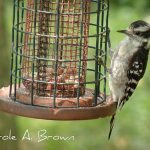Is Ecosystem Gardening too hard to learn? We talked about that recently, and my point was if we can learn to use an iphone we can learn to make the best choices possible to help wildlife in our gardens.
And to help us learn to create the best habitats for wildlife in our gardens, here are my top picks for the best resources, just in time for your holiday giving.
Bringing Nature Home: How Native Plants Sustain Wildlife in Your Garden, by Doug Tallamythe ground-breaking book that sets the standard! Should be read by every homeowner, school board, business park owner, in fact anyone who is responsible for managing any piece of land at all. Tallamy lays out a very compelling argument as to why native plants are so crucial to the survival of wildlife and why our gardens are so vital in creating wildlife habitat. Listen to my interview with Doug Tallamy where he moves from why native plants are so important to how to best use native plants in our gardens to attract more wildlife.
Noahs Garden: Restoring the Ecology of our Own Backyards, by Sara Steinbefore there was Bringing Nature Home, there was the lonely voice of Sara Stein advocating a new approach to how we garden. Sara Stein was also a ground-breaker with her emphasis on understanding the ecological functions at work in our gardens. Follow her personal journey to awareness of how our choices in the garden have impacts on the larger environment and can help wildlife, or sadly harm them. I keep returning to this book, and have re-read it at least once a year.
Urban and Suburban Meadows: Bringing Meadowscaping to Big and Small Spaces, by Catherine Zimmerman is the best step-by-step guide to installing a meadow, no matter how large (or how small) your space is. While there are other meadow books, some with stunningly beautiful photographs, this is the only book that focuses on why native plants are so important to creating wildlife habitat. Catherine has done an excellent job of guiding you through the planning process, preparing your site, planting your meadow, and how to maintain it. Not to be missed!
Designing Gardens with Flora of the American East, by Carolyn Summers is so good that I simply could not put it down. The stereotyped wildlife garden is messy and overgrown by some peoples standards. But Carolyn Summers shows how to design any style of garden that you want and still use native plants. Want a Japanese Garden, a formal allee, a knot garden, or a cottage garden? You can do it all by following Carolyns easy steps. Plus, shes got a whole chapter about how to buy native plants that is well worth the read. Listen to my interview with Carolyn Summers as she talks about how to best design our wildlife habitat gardens.
Energy Wise Landscape Design, a New Approach for Home and Garden, by Sue Reed is a wonderful description about how we can use the plants in our landscape to use less energy. We can make our homes warmer in winter and cooler in summer simply by using plants wisely in our gardens. Saving energy helps us and is beneficial to wildlife. What could be more win-win than that? And the great news is that by following Sues steps, this is really easy to do. Listen as Sue Reed describes the best ways to design your landscape to save energy in my interview with her.
Sustainable Gardening for Florida, by Ginny Stibolt is a great introduction to sustainable gardening and landscaping. In fact I highly recommend this book to everyone, even if you dont live in Florida. The principles discussed by Ginny are the same no matter where you live, and Ginny Stibolt does a wonderful job of pulling all of the best information together and presenting it in a way that will make you want to run right out into your garden and get started. Ginny has arranged this book like a cookbook, where you can choose your favorite recipe and get started with that. You can work your way through the recipes, creating more benefits with every one. Read my review of Ginny Stibolts Sustainable Gardening for Florida.
The Complete Idiots Guide to Composting by Chris McLaughlin, is a wonderful resource and review of the principles of soil health. Composting is valuable on so many levels: it keeps enormous amounts of waste from our landfills, it feeds and nourishes the soil and the wildlife that lives in the soil, and it feeds our plants making the purchase and application of toxic chemical fertilizers unnecessary. Learn how to turn your kitchen and yard waste into a valuable resource for your garden.
More From Ecosystem Gardening:
Submit your review | |








